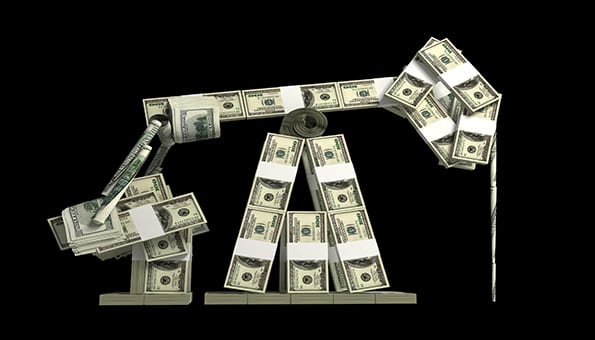It’s funny how the stock market works. It seems every week we have the fight of intraday bulls against the weekend selloff bears.
While scratched and bruised, neither of the beasts are winning.
As bright as the markets may look at times, there’s still a lot of economic issues that have yet to be fixed. From foreclosure troubles to unemployment, the markets remain shaky for all of the right reasons.
But have no fear…the US is here.
That may sound like an oxymoron, but the reality is that the US government has been doing a great job in keeping these markets from crumbling. They know that today’s modern world now lives through the capital markets (see Doubling Down for the Big Bang.)
As mentioned in our past issue Doubling Down for the Big Bang, Bernanke and the US government is spending to stimulate the stock market. They know that higher stock prices will encourage people to spend more and businesses to invest more. Combine that with low interest rates and a weak Greenback that makes U.S. exports more attractive to foreigners, they’re spending to rebuild the US.
Real estate won’t get us out of this jam like it did in 2005…the stock market will.
We can’t predict the future, but we do know the US won’t let the world see the trillions of dollars in stimulus go to waste. That means they’re not going to let the markets fall and will do whatever they can to protect it.
There’s no arguing that the stock market is the modern way of life for our global economy. If the N. American stock market collapses again, it means the US has failed.
The US won’t let that happen.
And that means high precious metals prices will continue to live on.
While our favourite way to play the precious metals boom is through commodities and resource stocks (particularly through the juniors), there are a lot of investors who prefer the ETF’s.
The ETF’s are a great way to cash in on the ups and downs of precious metals.
But before you do, make sure to remember that ETF’s, especially leveraged ETF’s, are for serious traders only and not for buy-and-hold traders!
There are many gold and silver ETF’s in both the US and Canada, including:
US:
SPDR Gold Shares (GLD), iShares Comex Gold Trust (IAU), ETFS Physical Gold Shares, iShares Silver Trust (SLV), and ETFS Physical Silver Shares (SIVR).
Canada (TSX):
HBP COMEX Gold ETF (HUG), HBP COMEX Silver ETF (HUZ), HBP COMEX Gold Bullion Bull+ & Bear+ ETF (HBU / HBD), HBP COMEX® Silver Bull+ & Bear+ ETF (HZU / HZD), HBP S&P/TSX Global Gold Inverse ETF (HIG), and HBP S&P/TSX Global Gold Bull+ & Bear+ ETF (HGU / HGD).
When you buy gold and silver physically backed ETFs, you’re not technically owning the physical metal but rather a fiat type paper representation. In simpler terms, it’s an IOU.
Generally, when you buy a share of a gold ETF, you “own” one tenth of an ounce of gold. When you buy silver, you own one ounce.
So where is the gold or silver?
The actual metal that you own is stored by a custodian such as a major bank like JP Morgan, or HSBC. These are the same namls that are being investigated for silver and gold manipulation (see Are the Banks Against You?).
But that’s a different topic all together and you should probably read “Are the Banks Against You?” to learn more.
But what you may not know is that the value of each share you own, or more specifically, the share-to-metal ratio, actually decreases the longer you hold it. The fund that manages the ETF must sell gold, for example, periodically to pay for expenses which decreases the amount of gold tied to each share.
That’s just one of the few reasons why ETF’s should NEVER be considered a long term investment.
Technically speaking, if investor demand is more than shares available, then the issuer/trustee must buy more physical metal to convert it into stock. Conversely, when investors sell and there are no buyers, then the metal must be redeemed and the trustee must then sell the metal equivalent of what was sold in shares.
While we can go on for days about how each of the ETF’s work, we need to remember the risks involved and the facts that are often hidden from the average investor.
For example, the world’s largest gold ETF the SPDR Gold Trust or better known as GLD, does not insure its gold. As the trustee, the GLD passes the storing of the their gold to the custodian, or the big banks.
But the bank is only responsible for damages to the gold they directly inflict.
What if the gold they have isn’t exactly real gold? What if it they were actually bars of copper painted gold?
Based on the prospectus, the custodian would be protected and the trustee wouldn’t be liable. There’s also no clear indication of the grade or quality of the gold you are buying.
You could be buying a shares of 80% gold when you think you’re buying pure gold:
“Neither the Trustee nor the Custodian independently confirms the fineness of the gold bars allocated to the Trust in connection with the creation of a Basket.”- Page 11 of the GLD’s prospectus
Furthermore, the gold you buy may not even be where you think it is.
Hidden in the GLD prospectus, a custodian is free to store the gold with sub-custodians until the gold is delivered to the custodian’s main vault. The sub-custodians can also store the gold with other sub-custodians! That means you have no idea where your gold might be.
At the end of the day, your gold could be in the hands of 10 different banks and you may not even know it!
That’s not the worst part.
Not only are the sub-custodians not accountable for the gold they store and are free to appoint other sub-custodians to hold the gold, the GLD (the trustee) has no right to visit the sub-custodians to examine the gold or check out its records.
What’s even crazier is the fact that the GLD can only check their gold in the banks on a limited basis. There is usually only one independent audit at the end of the year and one surprise audit per year.
Over the past year, we have discussed the role and possibility of precious metals manipulation in numerous newsletters (see the Silver Conspiracy). When it comes to ETF’s, herein lies yet another big controversy.
Conflict of Interest
Big banks like JP Morgan and HSBC, not only act as custodians but are allowed to have short positions in the gold and silver market. As mentioned in Are the Banks Against You, both JP Morgan and HSBC have the largest known short positions in silver.
Chris Powell, secretary and treasurer of the Gold Anti-Trust Action Committee, says “[We] doubt the reliability of the major gold and silver ETFs … [because] their metal can be borrowed by parties seeking to drive previous metal prices down, against the interest of ETF investors … [these short] positions are not disclosed in the ETF prospectuses.”
Not only do investors in ETF’s invest in precious metals with unknown quality, and invest in precious metals without knowing if their shares are actually backed by gold or silver, they invest in precious metals stored by the same guys that short them.
Regardless, as long as you can trade your ETF’s, you can still make money.
However, if you invest in leveraged ETF’s, such as Canada’s Horizons Betapros (HBP), you may have other worries.
HBP’s leveraged ETF’s entices investors by stating that their funds are rebalanced daily, so risk is limited to the initial invested capital. But that may not be a good thing, especially for buy and hold traders who believe they are actually buying gold through an ETF without having to store it.
For example, if gold goes up 10% one day, then you would realise a 20% gain based on HBP’s daily investment results equal to 200% the daily performance.
This is great if gold continues to gold up every day. But what if it goes up 10% one day, looses 5% the next, and gains 10% again the next day? Because the HBP’s are rebalanced daily, this may actually lead to losses that are unrecoverable over a longer period of time.
The Simple Math
Let’s use the HBP COMEX Gold Bullion Bull (HBU) for example, which seeks daily investment results equal to 200% the daily performance of COMEX Gold Bullion, before fees and expenses.
If gold declines 15% one day, it will need to gain 18% the next to get back to where it was.
A 15% decline for gold will result in a 30% decline in the HBU ETF.
That means that a 30% decline in HBU requires a 43% return to get back to where it was.
But since the HBU mimics the price of gold, when the gold market gets back to even by going up 18%, the HBU has only gone up by 36%, not the required 43%.
That’s an automatic loss of 7% in the HBU ETF, even though gold has broken even in two days!
While ETF’s can play a big part of an investor’s portfolio, we prefer to stick the juniors where we can buy and hold for the big leveraged gains.
There are a lot of great juniors out there that are still very undervalued. Our Special Report Edition junior silver companies this past year have all done very well, with some giving our readers gains of over 100%.
With the commodities markets expected to climb higher, we will be bringing you more of these stories soon enough. So stay tuned…a new Special Report Edition will be on its way.
Until next time,
Ivan Lo












